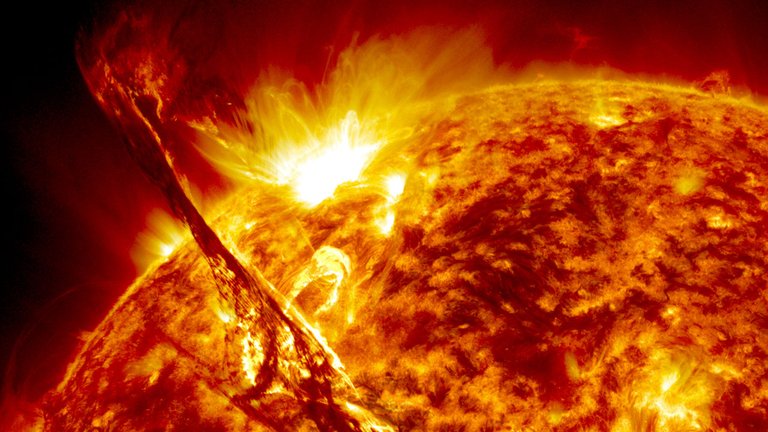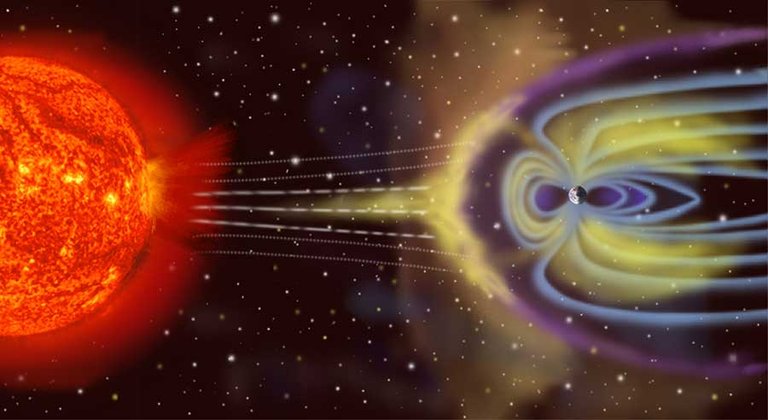It seems that the sun is the main object to investigate in the coming decade, so I didn't want to stop dedicating an article about the mysteries that surround it.
The sun. Our diabolical and even misunderstood nuclear reactor. Full of unpredictable moods, disturbing calms, outbursts of temper. Every 11 years the North Pole and the Magnetic South Pole exchange positions just before the start of the new Solar Maximum, i.e. at the threshold of the period of activity. The consequences of this reorientation of magnetism for the Earth range from harmless and precious auroras to solar storms that complicate (and even threaten) our lives. That depends on how strong, or how soft that Solar maximum is.
At the moment we are at a maximum, and the next solar minimum should be starting around 2019 or 2020. But while there are fewer sunspots and fewer eruptions on the surface for a minimum of time, this does not mean that the star is less active, but simply that its activity changes shape.
To the researchers' surprise, the #24 cycle, on which we are embarked, has been one of the weakest in the last 100 years (since we started measuring the solar heart rate). Recently, studies at Stanford University revealed that the reason may have to do with a new understanding of how plasma currents flow between the equator and the sun's poles (a kind of conveyor belt that runs above and below the solar surface). But experts continue to learn, and don't take a sudden tantrum for granted.
Sun is a star as fascinating as it is frustrating for astronomers who delve into its inner anatomy, take the pulse of its eruptions and comb its invisible hair of magnetic fields. Centuries of study and the latest space instruments have given us unprecedented information -- after all, this is the only star whose phenomena we can study in detail.
We have learned about his heart, which, heated to 15 million degrees Celsius, transforms every second four million tons of hydrogen into helium and light. We know that its magnetic fields are the ones that preside over the circulation of all solar matter. We have measured the black spots on its surface, where flashes 10,000 times more intense than its own light are born, and we periodically monitor its photosphere, which spits out plasma geysers and hyperaccelerated particles.
Experts have gone even further: they have compared the sun to other stars. They have made increasingly better and more realistic mathematical models. They have been able to see sunspots with great resolution, clearly capturing small tufts a few hundred kilometres high. They have even rebuilt solar activity millions of years ago, thanks to the moonstones brought by the Apollo missions.
We know that its magnetic influence (also called the'heliosphere') extends beyond Pluto, and that changes in its polarity are felt even at the threshold of interstellar space, where NASA's Voyager ships are.
Then, on the one hand, we can't complain. Since the year 2000, what had been a droplet count of solar discoveries became a flood. And a flotilla of six satellites (not counting the coming ones) dedicated solely to the sun, has raised fascinating questions: Who would have imagined that there is a small sun inside the sun, or that this strange and recently found area under the sun's surface, the tachocline, is truly responsible for the star's violence? Is it really the changing brilliance of the sun, and not our human activity, that is altering our temperature, or is that an argument created by a misinterpretation - deliberate or ignorant - of modern avant-garde solar science?
Yet, despite having his incredibly well-documented moods, the sun continues to put exasperating mysteries in our path. And not even the deepest sages of matter are able to predict exactly how they will behave, or guess when the next eruption will be. Ironically, now, the more tools we have to study the sun, the more vulnerable we are to its phenomena, especially electromagnetic ones. Never before have our societies been so dependent on this star, and never before has it been so urgent to understand the new science of heliophysics.
That is why we present here the five mysteries that resist all investigations. Five seemingly insignificant but critical gaps in knowledge that we have about our enigmatic star. Not only do they drive researchers crazy, but they profoundly affect space weather and our planetary system.
First mystery: cycles and pulses
For more than a century and a half we have known that every 11 years on average the sun is "active", that is, it is covered with dark spots and much colder (between 3,000 and 4,000 °C) than the rest of the surface. At the beginning of the cycle there are a few of them, they are isolated, and they are born in high latitudes, but as the years go by they become more numerous (more than a hundred can be formed in a single day) and migrate towards the equator, and then disappear again and plunge into a new period of minimal activity. Spots are regions containing strong magnetic fields that come from very deep and emerge through the solar surface, causing'boils' in the skin of the star. In other words, the spots are like "portals" that connect the heart of the sun to its atmosphere.
One would imagine that when there are more spots, since these are colder, the sun would also be colder. But the opposite is true.
"Clusters of spots, especially those with complex magnetic field configurations, are usually the site of solar flares, massive radiation tsunamis that are periodically spat out by the star," says Elizabeth Citrin, of the Solar Dynamics Observatory (SDO) at NASA's Goddard Space Center. "This radiation is composed of high-energy particles capable of damaging satellites and causing blackouts in our electrical systems.
The phenomenon of spotting cycles is related to the changing polarity of the star, every 11 years.
Why every 11 years? Why do they migrate to the equatorial regions? Why such a predictable cycle? Polarity changes on Earth, for example, not only occur every three million years, but are extremely irregular. Solar cycles are in fact related to terrestrial events of all kinds, including the position of the Gulf Stream, which seems to change every 11 years.
On a fundamental level, it is known that these cycles depend on the dynamo responsible for the magnetic activity of the star, and that it causes the so-called solar pulses: Thanks to the new science of helioseismology we are learning that the sun has pulses that go from top to bottom, as if it were a gigantic discotheque speaker. "Just as we can guess what happens beneath the surface of our planet when an earthquake occurs, we can guess what happens beneath the solar surface by this rapid pulsar and these internal plasma movements," says Dean Pesnell, an SDO physicist.
Or are they others, such as the rotation of the sun (faster at the equator than at the poles), convection, which transports heat from the interior to the surface, or the circulation of material between the meridians and the poles?
In other words, how does such chaos give rise to such a regular rhythm as that of 11 years old? Finally, although scientists have studied the reversal of the sun's polarity for decades, the process is still not well understood. This change, which begins in September, has already astonished scholars because one of the poles is moving ahead of the other.
"The north is already in transition, while the south has not started, and we don't understand why," says Jonathan Cirtain of NASA's Marshall Space Center.
Mystery number two: When cycles derail
source picture
Since we are used to this 11-year solar heartbeat (although it is thought that a normal cycle can be between 8 and 14 years old), with its periodic rhythms and spots, when things go off track, we do not understand it. That was what happened between 1645 and 1750, when the sun's pulse stopped completely. During those sixty years his face was unspotted. The period was christened the Maunder Minimum, and coincided with a time when Europe was plunged into a deep cold.
These'heart attacks' have occurred 27 times in the last 11,000 years, and it is not known what causes them, or whether the sun is still active but wrapped in a magnetic field too weak to produce the spots.
Without going any further, four years ago the sun showed that it is capable of surprising us, since it remained at a minimum level of activity for much longer than expected, contrary to all predictions.
"If we still don't understand the normal course of the sun, we're even less likely to understand these strikes," says Paul Charbonneau of the University of Montreal, who works with mathematical models of solar behavior. "We thought it might have something to do with the differences in solar rotation and plasma movements that cause the magnetic field.
The third mystery: the trigger of the eruptions
The eruptions are the intense sudden flashes followed by plasma geysers and ejections of the crown mass, in the form of dynamic loops. The matter beneath the sunspots, punished by the mind-blowing force of magnetic fields, seems to be the source of energy behind these phenomena. Sometimes, an access eruption leads to something more violent, a burp of a billion tons of magnetized plasma that explodes from the star amillions of miles per hour, lashing out at anything in its path. It's what experts call mass ejections from the crown.
Close-up, the loops of the crown are gigantic magnetic arcs filled with hot plasma at temperatures of more than one million degrees Celsius. They are anchored in the dense photosphere, the visible surface of the sun, and are the fundamental parts of the crown, which is the halo that can be seen surrounding the sun during an eclipse.
Experts say the problem here is to find that little imbalance that will trigger the eruption.
Lately, films have been made that perhaps explain part of this imbalance: it is believed that massive eruptions and ejections are guided by a process called'magnetic reconnection', during which lines in the plasma's magnetic field break and reconnect to lines flowing in the opposite direction.
At that point, the energy that has been building up for days or months is released in a few minutes. And that produces so much heat that it could explain the difference in temperature between the solar surface (about 5,600 °C) and the solar atmosphere (millions of degrees).
But the question remains: where does the spark that triggers the initial breakdown of the magnetic field lines come from? And how do the eruptions relate to the massive ejections of the crown, exactly? The problem is that, as we cannot directly observe the magnetic fields at a distance, we have to rely on indirect measurements, such as the shape of plasma currents.
One model suggests that eruptions may be born out of some instability just below the solar surface. And in that case, the magnetic energy would be transformed into light: the famous flashes of light. The second model proposes the opposite: that the magnetic field lines break in the upper atmosphere of the sun, more than 50,000 km from the surface, initiating a magnetic disturbance and spreading to the surface.
Astronomers are still far from knowing what the signs of a rash are, although they do know that when two sunspots of inverse polarity meet, they tend to create instabilities, and that s-shaped loops will sooner or later give birth to an eruption.
And most spectacularly, it is possible that magnetic arcs 400,000 km high in the solar atmosphere could connect sunspots in different hemispheres to each other.
Mystery four: Solar wind acceleration
The question has not been answered: How does the magnetic energy of eruptions transform into kinetic energy? That is, how does the sun drive the electrons, protons and ions of its hot plasma (which make up the so-called'solar wind') into space at almost the speed of light?
In one study, experts focus on analyzing the region where bubbles of one million tons of plasma are burped by the sun at 2,500 kilometers per second.
The particles that make up the plasma and the solar wind produce radiation at all wavelengths of the electromagnetic spectrum, from the radius to the range, although most of the eruptions fall into ranges outside the optic, so they are not visible to the human eye. Some computer models are trying to track their trajectory, speed and concentration, but we are still far from having a map about it. Nor can we predict solar flares to anticipate their consequences on Earth.
In 2010 the Voyager 1 probe determined that the solar wind speed, where the satellite was then (10.8 billion miles from Earth), is zero. That is, the point at which the sun's influence ends.
Fifth mystery: could there be a mega eruption?
A study by Japanese researchers at Kyoto University asked, in the May 2012 issue of the journal Nature, if our star could erupt a super eruption a thousand times more powerful than normal. The team used the Kepler probe to observe 148 similar stars in structure in the sun. And he discovered 14 of these monstrous storms in stars of the same type as ours - with a frequency of 800 to 5,000 years.
Now, does this conclusion apply to our sun? Opinions are divided. The truth is that no one has dared to model the effects of a mega-eruption on Earth.
Mystery Six: Why is the surface of the sun colder than the crown?
The surface of the sun boils at 5,726 degrees Celsius. But its atmosphere is 300 times warmer. No one has been able to cope with this solar mystery. If we assume that the heart of the sun is warmer and the rest of the star cools down from there to the outside, it would be logical for the crown to be colder than the surface. In 2015 NASA hypothesized that somehow the mechanism that heats the solar atmosphere has to do with millions of rather small heat bursts, but they explode every second or two, injecting tremendous heat into the crown.

It is possible that the recently launched probe will seek to solve these mysteries, there are also other conspiracy theories with a lot of logic that I will post about in the future when I have gathered enough information!
Once again thank you for following me and reading my blog!





Wow it is an excellent article about the sun.
There is much we could say and yet we know very little about it, your comment is very valuable to me and you have supported me with a vote. Thank you!
I'm following you from now on!
You can also earn by making delegation. Click here to delegateFollow this link to know more about delegation benefits.Congratulations, your post received 19.69% up vote form @spydo courtesy of @discernente! I hope, my gratitude will help you getting more visibility. to @spydo and earn 95% daily reward payout!
Electric Universe and Plasma Physics solves all mysteries.